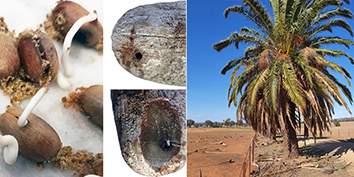Volume 8, Issue 2 (2022)
J. Insect Biodivers. Syst 2022, 8(2): 191-205 |
Back to browse issues page
Download citation:
BibTeX | RIS | EndNote | Medlars | ProCite | Reference Manager | RefWorks
Send citation to:



BibTeX | RIS | EndNote | Medlars | ProCite | Reference Manager | RefWorks
Send citation to:
Spennemann D H. Dispersal of the date stone beetle Coccotrypes dactyliperda (Coleoptera, Curculionidae, Scolytinae) in a managed rural landscape. J. Insect Biodivers. Syst 2022; 8 (2) :191-205
URL: http://jibs.modares.ac.ir/article-36-56640-en.html
URL: http://jibs.modares.ac.ir/article-36-56640-en.html
Institute for Land, Water and Society; Charles Sturt University; PO Box 789; Albury NSW 2640, Australia. , dhrspennemann@csu.edu.au
Abstract: (1972 Views)
View on Scopus
There are only limited experimental or observational data on vertical and horizontal flight capacity of Coccotrypes dactyliperda Fabricius, 1801 (Coleoptera, Curculionidae, Scolytinae), a major pest in date palm plantations throughout the Mediterranean and Middle East. This paper provides a set of proxy data, using actual observations of colonisation rates of Phoenix canariensis (Chabaud, 1882) (Arecales, Arecaceae) seeds in a linear planting array at Alma Park (NSW, Australia). The majority of dispersal movements occurs between adjacent or near adjacent seeds, followed by palms in close proximity with movements less than 4–5 m. While the maximum observed dispersal distance is 350 m, data suggest that a 36 m gap between two groups of palms is beyond the flight/dispersal range of most C. dactyliperda individuals and that colonisation over such distances would be a rare event. Since seed location is aided by temperature-sensitive alcohol-mediated kairomones, the chances of a beetle finding a new seed to colonise over longer distances are increasingly diminished during the summer months, thereby reducing reproductive success.
There are only limited experimental or observational data on vertical and horizontal flight capacity of Coccotrypes dactyliperda Fabricius, 1801 (Coleoptera, Curculionidae, Scolytinae), a major pest in date palm plantations throughout the Mediterranean and Middle East. This paper provides a set of proxy data, using actual observations of colonisation rates of Phoenix canariensis (Chabaud, 1882) (Arecales, Arecaceae) seeds in a linear planting array at Alma Park (NSW, Australia). The majority of dispersal movements occurs between adjacent or near adjacent seeds, followed by palms in close proximity with movements less than 4–5 m. While the maximum observed dispersal distance is 350 m, data suggest that a 36 m gap between two groups of palms is beyond the flight/dispersal range of most C. dactyliperda individuals and that colonisation over such distances would be a rare event. Since seed location is aided by temperature-sensitive alcohol-mediated kairomones, the chances of a beetle finding a new seed to colonise over longer distances are increasingly diminished during the summer months, thereby reducing reproductive success.
Article Type: Research Article |
Subject:
Biodiversity
Received: 2021/10/25 | Accepted: 2022/02/14 | Published: 2022/03/9
Received: 2021/10/25 | Accepted: 2022/02/14 | Published: 2022/03/9
References
1. AAL. (2022) Coccotrypes dactyliperda (Fabricius, 1801) [Online]. Canberra: Commonwealth Scientific and Industrial Research Organisation. Available at: https://bie.ala.org.au [Accessed 31th January 2022].
2. Atkinson, T.H. & Peck, S.B. (1994) Annotated checklist of the bark and ambrosia beetles (Coleoptera: Platypodidae and Scolytidae) of tropical southern Florida. Florida Entomologist, 77, 313-329. [DOI:10.2307/3496101]
3. Badawi, A.I., Saleh, M.R. M. & Kamel, A.H. (1977) Susceptibility of different date varieties to infestation with certain pests and the effect of tree height on the rate of infestation. Agricultural Research Review, 55, 9-13.
4. Bar-Shalom, O. & Mendel, Z. (2001) Seasonal changes in the seed bank in date palm (Phoenix dactylifera) orchards and the involvement of the date-stone beetle (Coccotrypes dactyliperda). Phytoparasitica, 29, 84-85.
5. Beaver, R.A. & Löyttyniemi, K. (1991) Annual flight patterns and diversity of bark and ambrosia beetles (Col., Scolytidae and Platypodidae) attracted to bait logs in Zambia. Journal of Applied Entomology, 112, 505-511. [DOI:10.1111/j.1439-0418.1991.tb01084.x]
6. Blumberg, D. (2008) Date palm arthropod pests and their management in Israel. Phytoparasitica, 36, 411-448. [DOI:10.1007/BF03020290]
7. Blumberg, D. & Kehat, M. (1982) Biological studies of the date stone beetle, Coccotrypes dactyliperda. Phytoparasitica, 10, 73-78. [DOI:10.1007/BF02981129]
8. Bureau of Meteorology (2022a) Climate statistics for Australian locations. Monthly climate statistics. Albury Airport (station nº 072146). Retrieved from http://www.bom.gov.au/climate/averages/tables/cw_072146.shtml [Accessed 13 February 2022].
9. Bureau of Meteorology (2022b) Climate statistics for Australian locations. Monthly climate statistics. Narrandera Golf Club (station nº 074221). Retrieved from http://www.bom.gov.au/climate/averages/tables/cw_074221.shtml [Accessed 13 February 2022].
10. Bureau of Meteorology (2022c) Climate statistics for Australian locations. Monthly climate statistics. Wagga Wagga AMO (station nº 072150). Retrieved from http://www.bom.gov.au/climate/averages/tables/cw_072150.shtml [Accessed 13 February 2022]
11. Comparini, C., Gallego, D., Núñez, L., Closa, A.M. & Salord, M.D.M.L. (2018) First record of four scolytid species (Coleoptera: Curculionidae) in the Balearic Islands (Western Mediterranean; Spain). Journal of the Entomological Research Society, 20, 61-70.
12. de Abreu, R.L.S., Ribeiro, G.D.A., Vianez, B.F. & Sales-Campos, C. (2012) Insects of the subfamily Scolytinae (Insecta: Coleoptera, Curculionidae) collected with pitfall and ethanol traps in primary forests of central Amazonia. Psyche: A Journal of Entomology, 2012, 480520. [DOI:10.1155/2012/480520]
13. Eichhoff, W. (1879) Ratio, descriptio, emendatio eorum Tomicinorum qui sunt in Dr. Chapuisi et autoris ipsius collection et autoris ipsius collectionibus et quos praeterea recognovit. Mémoires de la Société Royale des Sciences de Liege, 8, 1-554.
14. El-Barbary, N.S., Donia, A.R. & Mostafa, A.M. (2002) Effect of food preference and extracts of the date palm fruits and stones on the activity of the adult females of the date stone beetle, Coccotrypes dactyliperda Fabricius (Coleoptera, Scolytidae). Alexandria Journal of Agricultural Research, 47, 103-107.
15. El-Sufty, R. & Helal, R.M. (1998) Studies on the date stone beetle, Coccotrypes dactyliperda F. (Col: Scolytidae) in North of Nile Delta. Menofiya Journal of Agricultural Research, 23, 1683-1692.
16. Fabricius, J.C. (1801) Systema eleutheratorum secundum ordines, genera, species: adiectis synonymis, locis, observationibus, descriptionibus. Bibliopoli Academici Novi, Kiliae, 2, 687 pp.
17. Gottlieb, D., Holzman, J., Lubin, Y., Bouskila, A., Kelley, S. & Harari, A. (2009) Mate availability contributes to maintain the mixed-mating system in a scolytid beetle. Journal of Evolutionary Biology, 22, 1526-1534. [DOI:10.1111/j.1420-9101.2009.01763.x]
18. Gottlieb, D., Lubin, Y., Bouskila, A., Gordon, D. & Harari, A. (2011) Time limitation affects offspring traits and female's fitness through maternal oviposition behaviour. Biological Journal of the Linnean Society, 102, 728-736. [DOI:10.1111/j.1095-8312.2011.01606.x]
19. Herfs, A. (1950) Studien an dem Steinnußborkenkäfer Coccotrypes tanganus Eggers. 2. Die Soziologie von Coccotrypes tanganus. Höfchen-Briefe für Wissenschaft und Praxis (Bayer Leverkusen), 3, 3-31.
20. Holzman, J.P., Bohonak, A.J., Kirkendall, L.R., Gottlieb, D., Harari, A.R. & Kelley, S.T. (2009) Inbreeding variability and population structure in the invasive haplodiploid palm‐seed borer (Coccotrypes dactyliperda). Journal of Evolutionary Biology, 22, 1076-1087. [DOI:10.1111/j.1420-9101.2009.01722.x]
21. Hussein, A.E. (1990) Date varieties and palm height in relation to infestation with date stone beetle, Coccotrypes dactyliperda F. (Coleoptera: Scolytidae). Annals of Agricultural Science, Moshtohor, 28, 2613-2622.
22. Jordal, B.H., Normark, B.B., Farrell, B.D. & Kirkendall, L.R. (2002) Extraordinary haplotype diversity in haplodiploid inbreeders: phylogenetics and evolution of the bark beetle genus Coccotrypes. Molecular Phylogenetics and Evolution, 23, 171-188. [DOI:10.1016/S1055-7903(02)00013-1]
23. Kees, A.M., Hefty, A.R., Venette, R.C., Seybold, S.J. & Aukema, B.H. (2017) Flight capacity of the walnut twig beetle (Coleoptera: Scolytidae) on a laboratory flight mill. Environmental Entomology, 46, 633-641. [DOI:10.1093/ee/nvx055]
24. Kehat, M., Blumberg, D. & Greenberg, S. (1976) Fruit drop and damage in dates: the role of Coccotrypes dactyliperda F. & nitidulid beetles, and prevention by mechanical measures. Phytoparasitica, 4, 93-99. [DOI:10.1007/BF02980340]
25. Letzner, C.W. (1840) Ueber den Bistrochus dactyliperda und seine frühern Stände. Uebersicht der Arbeiten und Veränderungen der Schlesischen Gesellschaft für Vaterländische Cultur in Jahre 1839, 17, 116-120.
26. Mazón, M., Díaz, F. & Gaviria, J.C. (2013) Effectiveness of different trap types for control of bark and ambrosia beetles (Scolytinae) in Criollo cacao farms of Mérida, Venezuela. International Journal of Pest Management, 59, 189-196. [DOI:10.1080/09670874.2013.810794]
27. MedCalc Software (2018) MEDCALC. Fisher exact probability calculator. Ostend, Belgium, Available at: https://www.medcalc.org/calc/fisher.php [Accessed 31th January 2022].
28. Meisner, J., Weissenberg, M., Blumberg, D. & Ascher, K.R.S. (1985) Date palm fruit stone extracts as phagostimulants for the adult date stone beetle, Coccotrypes dactyliperda F. (Coleoptera: Scolytidae). Zeitschrift für Pflanzenkrankheiten und Pflanzenschutz, 92, 305-309.
29. Menocal, O., Kendra, P.E., Montgomery, W.S., Crane, J.H. & Carrillo, D. (2018) Vertical distribution and daily flight periodicity of ambrosia beetles (Coleoptera: Curculionidae) in Florida Avocado orchards affected by Laurel Wilt. Journal of Economic Entomology, 111, 1190-1196. [DOI:10.1093/jee/toy044]
30. Pinheiro, G.C. & Flechtmann, C.A.H. (2015) Influence of fire on the diversity of Scolytinae and Platypodinae (Curculionidae) in Hevea Brasiliensis in São Paulo state (Brazil). IV Congresso Brasileiro de Heveicultura, 24-26 June 2015. São José do Rio Preto.
31. Ramírez, B.H., Parrado-Rosselli, Á. & Stevenson, P. (2009) Seed dispersal of a useful palm (Astrocaryum chambira Burret) in three amazonian forests with different human intervention. Revista Colombia Forestal, 12, 5-16. [DOI:10.14483/udistrital.jour.colomb.for.2009.1.a01]
32. Schedl, K.E. (1961) Scolytidae und Platypodidae Afrikas. Revista de Entomologia de Mocambique, 4, 355-742.
33. Spennemann, D.H.R. (2018a) An experimental evaluation of food preferences and associated hatching times of the date stone beetle, Coccotrypes dactyliperda (Scolytinae, Coleoptera). Institute for Land, Water and Society Report. Albury, NSW: Institute for Land, Water and Society, Charles Sturt University.
34. Spennemann, D.H.R. (2018b) Global distribution of the date stone beetle, Coccotrypes dactyliperda (Coleoptera: Curculionidae, Scolytinae). Journal of Insect Biodiversity and Systematics 4, 203-226.
35. Spennemann, D.H.R. (2018c) Phoenix canariensis seed encountered in scats and ejecta collected at Alma Park. Albury, NSW: Institute for Land, Water and Society, Charles Sturt University.
36. Spennemann, D.H.R. (2019a) Biology, ecology and distribution of the date stone beetle, Coccotrypes dactyliperda (Scolytinae, Coleoptera). Zoology in the Middle East, 65, 163-182. [DOI:10.1080/09397140.2019.1571743]
37. Spennemann, D.H.R. (2019b) Resilience of the date stone beetle Coccotrypes dactyliperda (Coleoptera, Curculionidae), following periods of exposure to subzero temperature. Turkish Journal of Entomology, 43, 379-385. [DOI:10.16970/entoted.530263]
38. Spennemann, D.H.R. (2020a) Background to the Palms at Alma Park (NSW) I: Alma Park Lutheran Church. Albury, NSW: Institute for Land, Water and Society, Charles Sturt University.
39. Spennemann, D.H.R. (2020b) Background to the Palms at Alma Park (NSW) II: Netherlands Homestead. Albury, NSW: Institute for Land, Water and Society, Charles Sturt University.
40. Spennemann, D.H.R. (2020c) Background to the Palms at Alma Park (NSW) III: Glenalvon Homestead. Albury, NSW: Institute for Land, Water and Society, Charles Sturt University.
41. Spennemann, D.H.R. (2020d) Resilience of breeding Coccotrypes dactyliperda (Coleoptera, Curculionidae, Scolytinae) to ingestion by vertebrates. Turkish Journal of Entomology, 44, 205-217. [DOI:10.16970/entoted.622103]
42. Spennemann, D.H.R., Kent, K. & Cook, R. (2018) Uninvited guests: Mass Emergence of Scolytinid Beetles in a Seed Germination Experiment and its Management. Institute for Land, Water and Society Report. Albury, NSW: Institute for Land, Water and Society, Charles Sturt University.
43. Spennemann, D.H.R. & Pike, M. (2019) Rites of Passage: germination of regurgitated and defecated Phoenix canariensis seeds. Proceedings of the Linnean Society of New South Wales, 141, 49-59.
Send email to the article author
| Rights and permissions | |
 |
This work is licensed under a Creative Commons Attribution-NonCommercial 4.0 International License. |










